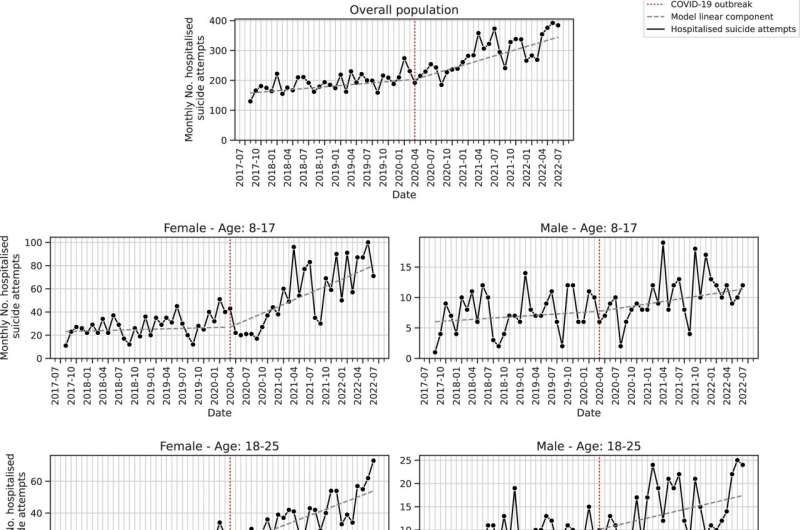This article has been reviewed according to Science X's editorial process and policies. Editors have highlighted the following attributes while ensuring the content's credibility:
fact-checked
trusted source
proofread
New epidemiological surveillance indicators for more effective monitoring of suicide attempts

Research teams, coordinated by Romain Bey and Prof. Richard Delorme, have developed novel digital tools to improve mental health monitoring for people living in the Greater Paris region.
The data in this retrospective study were generated by analyzing several million hospitalization records. The results of the study were published in npj Mental Health Research.
Teams from the Paris Public Hospital Network (AP-HP) and the Institut Pasteur set out to identify new epidemiological parameters to improve mental health monitoring during crises for people living in Greater Paris. They did so by developing digital tools that automatically analyze millions of documents contained in the electronic health records of hospitalized patients using an artificial intelligence algorithm devised by data scientist Ariel Cohen.
To improve our understanding of the impact of the COVID-19 crisis on the suicidality of people living in Greater Paris, the scientists studied the dynamics of suicide attempts before and during the pandemic, aiming to determine the prevalence of certain known risk factors such as social isolation, a history of suicide attempts, and domestic, physical or sexual violence.
The detailed analysis of nearly three million hospitalization records from 15 different AP-HP hospitals was made possible by the AP-HP clinical data warehouse, a secure platform containing huge volumes of data collected during health care delivery that can be pseudonymized and analyzed.
Using natural language processing algorithms, 14,023 hospitalizations for suicide attempts were identified for the two sub-periods of study: before the pandemic (August 1, 2017, to February 29, 2020) and during the pandemic (March 1, 2020, to June 30, 2022).
"An increase in the number of suicide attempts was observed during the COVID-19 period. There were twice as many suicide attempts by women as by men during these periods. The increase in suicide attempts was particularly notable among girls and young women aged 8 to 25. Alarmingly, domestic, physical, and sexual violence were risk factors that were regularly mentioned in the hospital records for girls and young women," commented Prof. Delorme, a scientist in the Human Genetics and Cognitive Functions Unit at the Institut Pasteur and Head of the Child and Adolescent Psychiatry Department at Robert Debré Hospital (AP-HP).
In the wake of the COVID-19 pandemic, this retrospective study highlights the scale of violence towards women, including at a young age. It also shows that analyzing the huge quantities of data collected in the AP-HP clinical data warehouse can lead to more effective monitoring of the health needs of people living in Greater Paris, especially by improving our understanding of their mental health.
More information: Romain Bey et al, Natural language processing of multi-hospital electronic health records for public health surveillance of suicidality, npj Mental Health Research (2024). DOI: 10.1038/s44184-023-00046-7


















